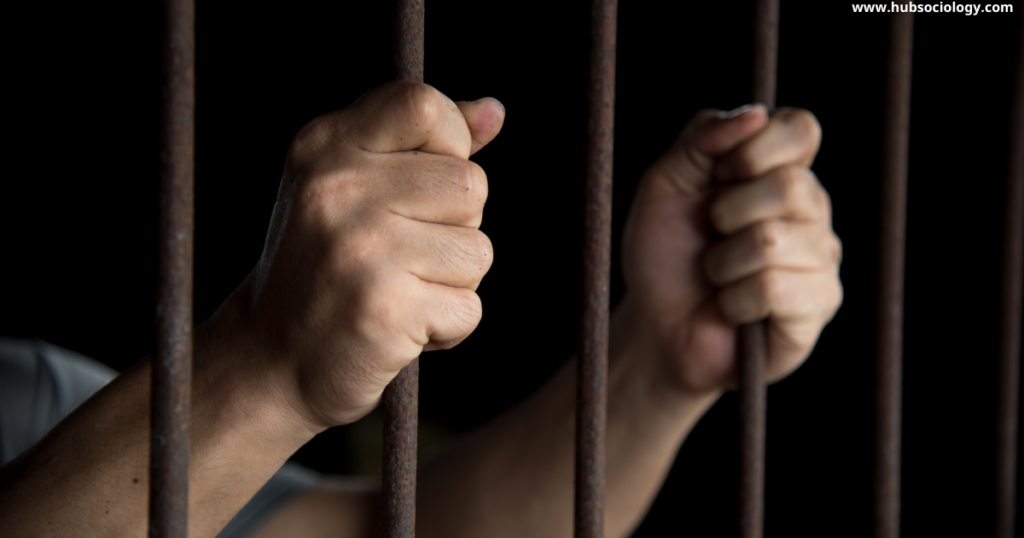Introduction

Prisons are a critical institution in any society, serving as a mechanism for punishment, deterrence, and rehabilitation. However, from a sociological perspective, prisons also reflect broader social inequalities, structural violence, and state power. In India, the prison system is plagued by overcrowding, poor living conditions, and systemic discrimination against marginalized communities. Analyzing prison statistics provides insights into the criminal justice system’s functioning, the socio-economic background of inmates, and the state’s approach to crime and punishment.
This article examines prison statistics in India through a sociological lens, focusing on key issues such as overcrowding, undertrial prisoners, caste and religion-based disparities, and the challenges of rehabilitation.
1. Overcrowding in Indian Prisons
One of the most pressing issues in Indian prisons is severe overcrowding. According to the National Crime Records Bureau (NCRB) Prison Statistics India 2021:
- Total prison population: 5,54,034
- Actual capacity of prisons: 4,25,609
- Occupancy rate: 130.2% (meaning prisons are holding 30% more inmates than their capacity)
Sociological Implications of Overcrowding
- Dehumanizing Conditions: Overcrowding leads to poor hygiene, inadequate medical facilities, and increased violence among inmates.
- Violation of Human Rights: The Supreme Court of India has repeatedly highlighted that overcrowding violates prisoners’ fundamental rights under Article 21 (Right to Life and Personal Liberty).
- Psychological Impact: Prolonged confinement in cramped spaces leads to mental health issues such as depression and anxiety.
From a sociological perspective, overcrowding is not just a logistical problem but a reflection of systemic failures—delayed trials, excessive use of incarceration for petty crimes, and lack of alternative sentencing mechanisms.
2. Undertrial Prisoners: A Crisis of Justice
A shocking aspect of India’s prison statistics is the high proportion of undertrial prisoners—those awaiting trial or sentencing.
- Percentage of undertrials in prisons (2021): 76.1% (4,27,165 out of 5,54,034 inmates)
- Average duration of stay for undertrials: 1-3 years (some even longer)
Why Are Undertrials Overrepresented?
- Delayed Justice: India’s judicial system is notoriously slow, with millions of pending cases.
- Economic Disparities: Poor inmates cannot afford bail or legal representation, while wealthier individuals secure quicker release.
- Discriminatory Policing: Marginalized groups (Dalits, Adivasis, Muslims) are more likely to be arrested and denied bail.
Sociological Analysis
The high number of undertrials indicates a criminalization of poverty. Sociologists argue that prisons are not just for punishing criminals but also for controlling the poor and marginalized. The Marxist perspective suggests that the criminal justice system works in favor of the ruling class, while the poor are disproportionately criminalized.

3. Caste, Religion, and Prison Demographics
Prison statistics reveal stark disparities based on caste and religion.
Caste-Based Disparities (NCRB 2021)
- Scheduled Castes (SCs): 21.6% of prisoners (despite being 16.6% of India’s population)
- Scheduled Tribes (STs): 12.1% of prisoners (compared to 8.6% of the population)
- Other Backward Classes (OBCs): 34.7%
Religion-Based Disparities
- Muslims: 18.7% of prisoners (compared to 14.2% of the population)
- Hindus: 71.7% of prisoners (roughly proportional to population)
Sociological Interpretation
- Structural Discrimination: Higher incarceration rates among SCs, STs, and Muslims suggest systemic bias in policing and judiciary.
- Criminalization of Marginalized Groups: Police often target lower castes and minorities under laws like the Prevention of Atrocities Act or UAPA, leading to arbitrary arrests.
- Intersectionality: Poor Dalit or Muslim individuals face compounded disadvantages in the justice system.
4. Gender and Prison Statistics
Women constitute a small but vulnerable segment of the prison population.
- Total female prisoners (2021): 19,913 (3.6% of total inmates)
- Undertrial women: 73.5%
- Women in conflict with law often charged under: Domestic violence, dowry cases, or drug offenses.
Sociological Issues Faced by Women Prisoners
- Stigmatization: Women prisoners face severe social ostracization post-release.
- Lack of Facilities: Many women’s prisons lack proper healthcare, especially for pregnant inmates.
- Children in Prisons: Over 1,800 children live in prisons with their mothers, affecting their upbringing.
Feminist scholars argue that women’s incarceration is often linked to patriarchal control—many are imprisoned for defying familial or societal norms.
5. Rehabilitation and Recidivism
India’s prison system focuses more on punishment than rehabilitation.
- Recidivism rate: No official national data, but studies suggest 40-50% of released prisoners reoffend due to lack of reintegration support.
- Vocational training programs: Only 28% of prisons provide skill development initiatives.
Sociological Perspective on Rehabilitation
- Labeling Theory (Becker): Once labeled as a criminal, individuals find it hard to reintegrate into society, pushing them back into crime.
- Lack of Social Support: Former prisoners face discrimination in jobs and housing, increasing chances of reoffending.
6. Conclusion: Prisons as a Mirror of Society
Prison statistics in India reveal deep-seated inequalities and systemic failures. Overcrowding, undertrial imprisonment, caste-religion disparities, and poor rehabilitation highlight how the prison system perpetuates social injustice rather than ensuring justice.
Key Takeaways for Sociology Students:
- Prisons reinforce social hierarchies—marginalized groups are disproportionately incarcerated.
- The justice system is biased—economic and caste privileges determine who gets punished.
- Reforms are needed—alternative sentencing, speedy trials, and rehabilitation must be prioritized.
Understanding prison statistics sociologically helps us question not just the prison system but the larger structures of power and inequality in society.

Topic Related Questions
5-Mark Questions (Short Answer)
- Define undertrial prisoners. Why do they constitute a large proportion of India’s prison population?
- What is the occupancy rate of Indian prisons as per NCRB 2021? What are its implications?
- How does caste discrimination reflect in India’s prison statistics?
- Briefly explain the concept of ‘criminalization of poverty’ in the context of Indian prisons.
- What are the major challenges faced by women prisoners in India?
- What is the role of the National Crime Records Bureau (NCRB) in prison data collection?
- How does the slow judicial process contribute to prison overcrowding in India?
- What is the significance of the Supreme Court’s intervention in prison reform cases?
- Why are mental health issues prevalent among Indian prisoners?
- How does the bail system discriminate against poor undertrials?
10-Mark Questions (Detailed Answer)
- Discuss the sociological reasons behind the overrepresentation of marginalized communities (SCs, STs, Muslims) in Indian prisons.
- Explain how overcrowding in Indian prisons violates fundamental rights and impacts inmates’ mental health.
- Analyze the role of economic disparities in the high number of undertrial prisoners in India.
- How does the labeling theory explain the difficulties faced by ex-convicts in reintegrating into society?
- Critically examine the gender disparities in India’s prison system with reference to NCRB data.
- “Prisons are a microcosm of societal inequalities.” Discuss with reference to caste and religious representation in Indian jails.
- How does the overuse of custodial detention for petty crimes violate the principle of justice?
- Examine the impact of prison overcrowding on inmates’ human rights with case studies.
- Why do marginalized communities (SCs/STs/OBCs) face higher arrest rates? Analyze from a sociological perspective.
- Discuss the role of media in shaping public perception of prisoners and its consequences.
15-Mark Questions (Essay-Type Answer)
- “Prisons in India reflect broader social inequalities.” Discuss this statement with reference to caste, religion, and class-based disparities in incarceration rates.
- Examine the failures of the Indian criminal justice system in light of the high percentage of undertrial prisoners. Suggest reforms from a sociological perspective.
- How does the Marxist perspective explain the function of prisons in maintaining social control? Apply this to the Indian context.
- Discuss the challenges of prison rehabilitation in India. Why does recidivism remain high despite government initiatives?
- “The Indian prison system is more about punishment than reform.” Critically evaluate this statement using sociological theories and prison statistics.
- Critically analyze the effectiveness of the Open Prison System in India as an alternative to traditional incarceration.
- How does Michel Foucault’s concept of ‘disciplinary punishment’ apply to the functioning of Indian prisons?
- “The Indian prison system perpetuates cycles of crime rather than reforming offenders.” Evaluate this statement.
- Discuss the intersection of gender, poverty, and incarceration with reference to women prisoners in India.
- Compare the Indian prison system with that of a Western country (e.g., USA/Norway) from a reformative justice perspective.
Bonus: Applied/Case-Based Questions
- Study the 2021 NCRB data on prison demographics. What trends do you observe in the incarceration of Muslims and Dalits? (10 marks)
- After reading about the Tihar Jail reforms, discuss whether such models can be replicated nationwide. (15 marks)
- How would Durkheim’s theory of ‘punishment as a social function’ explain India’s prison crisis? (10 marks)
Further Study Questions (10-15 Marks Each)
- A 2024 report reveals that 80% of Delhi’s undertrials belong to SC/ST/OBC communities. Apply Conflict Theory to analyze this data.
- “Kerala’s open prison model has a recidivism rate of just 8% compared to the national 40%.” What sociological factors explain this success?
- Imagine a new law mandates GPS ankle monitors instead of jail for petty crimes. Predict its impact using Labeling Theory.
- Compare Tihar Jail’s privatized cafeteria system (run by inmates) with Maharashtra’s state-run kitchens using Marxist labor theory.
- Norway’s Halden Prison spends ₹50 lakh/year per inmate; India spends ₹30,000. Is this disparity justified? Argue with Durkheim’s solidarity concept.
- AI-powered risk assessment tools are being piloted to reduce pretrial detention. Could this worsen caste bias? Apply Algorithmic Discrimination theory.
- A survey shows 72% of women prisoners are first-time offenders in domestic violence cases. How does Feminist Criminology explain this?
- Prisons in Bihar have 200% occupancy but the state opposes early releases citing “public safety.” As a policymaker, how would you balance rights and security?

1 thought on “Prisons Statistics in India: A Sociological Perspective”